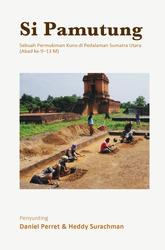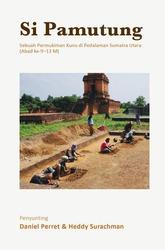
Daniel Perret
qnavry.creerg@rsrb.argten.oefe@terrep.leinadChercheur.e statutaire
Statutaire / rattachement : EFEO / Archéologie / IndonésieInstitution de rattachement principal : Centre Asie du Sud-EstFormation et parcours professionnel
Training and career
Après l’obtention d’un doctorat de troisième cycle nouveau régime (spécialité Histoire et Civilisations) à l’EHESS Paris début 1994, Daniel Perret est recruté la même année par l’Ecole française d’Extrême-Orient (EFEO) en tant qu’allocataire de recherche associé en poste à Kuala Lumpur (Malaisie). Il est ensuite chercheur contractuel à l’EFEO de 1995 à 2003, responsable du centre de Kuala Lumpur jusqu’à janvier 2000, puis responsable du centre de Jakarta jusqu’à décembre 2002. Il devient Maître de conférences de l’EFEO en septembre 2003 et est de nouveau affecté à Jakarta de septembre 2005 à août 2007, puis responsable du centre EFEO de Kuala Lumpur à partir de septembre 2007. Après avoir obtenu le diplôme d’Habilitation à Diriger des Recherches (HDR) en 2008, il est Directeur d’études depuis 2013. En 2022, parallèlement à sa fonction de responsable du centre EFEO de Kuala Lumpur basé à la Faculté des Arts et Sciences Sociales de l’Universiti Malaya, il est également Visiting Professor au sein de cette même université.
After obtaining a Ph.D. (specialty History and Civilizations) at EHESS Paris in early 1994, Daniel Perret was recruited that same year by the French School of Asian Studies (EFEO) as associate research fellow based in Kuala Lumpur (Malaysia). He was then contract researcher at EFEO from 1995 to 2003, head of the Kuala Lumpur centre until January 2000, then head of the Jakarta centre until December 2002. He became a lecturer at EFEO in September 2003 and was again posted in Jakarta from September 2005 until August 2007, then head of the EFEO centre in Kuala Lumpur from September 2007. After obtaining the HDR diploma in 2008, he became Director of Studies in 2013. In 2022 , in addition to his role as head of the EFEO centre in Kuala Lumpur based at the Faculty of Arts and Social Sciences of the Universiti Malaya, he is also Visiting Professor at the same university.
Recherches en cours
Current research
En 2022, Daniel Perret conduit plusieurs programmes de recherche.
Il mène depuis 2018 un programme archéologique consacré aux sites de Bongkisam et Sungai Jaong dans la région du delta du fleuve Sarawak, dans l’Etat de Sarawak, en Malaisie. Redécouverts après la Seconde guerre mondiale, ces deux sites ont fait l'objet de fouilles sommaires jusqu'au milieu des années 1960, livrant notamment de grandes quantités de céramiques chinoises, de poteries et de scories de fer, ainsi que les vestiges d'une petite structure hindo-bouddhique en pierre, unique à ce jour dans cet État. Le but de ce programme, mené en coopération avec le Département des musées de Sarawak, est de reprendre l'étude de ces sites (datés provisoirement entre la fin du premier millénaire et le début du second) par de nouvelles fouilles destinées à préciser leur chronologie, leur organisation, les activités qui y étaient menées, ainsi que leurs rapports avec le monde extérieur.
Un programme d’étude de l'histoire de la ville de Johor Bahru, capitale de l'État méridional de Johor fondée au milieu du XIXe siècle, a été initié en 2016 par Daniel Perret en coopération avec la Faculté des Arts et Sciences Sociales de l’université Malaya. Daniel Perret s'intéresse tout particulièrement aux premiers moments de l'histoire des implantations chrétiennes dans la ville, aux représentations de la ville dans les sources locales et étrangères entre sa fondation et 1930, ainsi qu’à l’étude des plans anciens de la ville.
L’histoire de la côte ouest de Sumatra, longue de plus de 2.000 kilomètres, reste sous-étudiée. C'est pourquoi Daniel Perret a lancé en mars 2021 un programme de recherche sur cette région théâtre de tensions entre plusieurs puissances (Aceh, Minangkabau, VOC, EIC, Banten) à des époques diverses. Il s'agira d'examiner notamment d'une part comment s'organisent et évoluent les espaces économiques et politiques de cette région, d'autre part la circulation des hommes, des idées et des biens le long de cette côte entre le XVIe et le XIXe siècles. Dans le prolongement des recherches archéologiques menées entre 1995 et 2005, c’est la petite ville de Barus qui constitue le premier objet d’étude de ce programme.
In 2022, Daniel Perret is conducting several research programs.
Since 2018, he has been leading an archaeological research program devoted to the sites of Bongkisam and Sungai Jaong in the Sarawak River Delta region, state of Sarawak, Malaysia. Rediscovered after the Second World War, both sites were excavated intermittently until the mid-1960s, yielding in particular large quantities of Chinese ceramics, earthenware and iron slag, as well as the remains of a small Hindo-Buddhist stone structure, unique to this day in Sarawak. The aim of this program, carried out in cooperation with the Sarawak Museum Department, is to resume the study of these sites (provisionally dated between late first millennium and early second millennium) through new excavations intended to clarify their chronology, their organization, the activities carried out there, as well as their relations with the outside world.
A program to study the history of the city of Johor Bahru, capital of the southern state of Johor founded in the middle of the 19th century, was initiated in 2016 in cooperation with the Faculty of Arts and Social Sciences of the University of Malaya in Kuala Lumpur. Daniel Perret’s research is presently focused on the history of early Christian activities in the city, on representations of the city in local and foreign sources between its foundation and 1930, as well as the study of old city maps.
The history of the west coast of Sumatra, more than 2,000 kilometers long, remains understudied. Daniel Perret therefore launched a research program in March 2021 on this region, the scene of tensions between several powers (Aceh, Minangkabau, VOC, EIC, Banten) at various times. Aspects of the research include notably on the one hand how the economic and political spaces of this region are organized and evolve, on the other hand the circulation of men, ideas and goods along this coast between the sixteenth and nineteenth centuries. As an extension of the archaeological research carried out there between 1995 and 2005, the small town of Barus is the first object of study for this program.
Responsabilités
Duties
En 2022
In 2022
- Responsable du Centre EFEO de Kuala Lumpur
Head of the EFEO centre in Kuala Lumpur (Malaysia)
- Co-responsable de la mission archéologique Sungai Jaong et Bongkisam (Sarawak, Malaisie)
Co-Head of the Sungai Jaong and Bongkisam ((Sarawak, Malaysia) archaeological project
- Coordinateur pour l'EFEO du Bulletin Archéologique des Écoles françaises à l'Étranger
Coordinator for EFEO of the Bulletin Archéologique des Écoles françaises à l'Étranger
- Membre du comité de lecture de la revue Archipel (Etudes interdisciplinaires sur le monde insulindien)
Member of the editorial board of the journal Archipel (Interdisciplinary Studies on the Insulindian World)
Bibliographie sélective
Selective bibliography
(pour une bibliographie complète, voir https://hal-cnrs.archives-ouvertes.fr/search/index/?q=daniel+perret&submit)
(for a comprehensive bibliography, see https://hal-cnrs.archives-ouvertes.fr/search/index/?q=daniel+perret&submit)
- 2022 - Perret, D. & J. Santos Alves (ed.). Archipel Hors-Série no. 2 : Patani Through Foreign Eyes: Sixteenth and Seventeenth Centuries, 314 p.. https://journals.openedition.org/archipel/
- Perret D., Titi Surti Nastiti, Arlo Griffiths (ed.) (2021-). Inventaris Daring Epigrafi Nusantara Kuno / Online Inventory of Ancient Nusantaran Epigraphy. https://heurist.huma-num.fr/heurist/?db=IDENK&website&id=40775.
- 2018 - Perret D. (ed.). Writing for Eternity : A Survey of Epigraphy in Southeast Asia, Paris, EFEO(n° 30):480 p.. Réf. HAL: halshs-02175479
- 2014 - Perret D. (ed.). History of Padang Lawas, North Sumatra, II. Societies of Padang Lawas (Mid-Ninth – Thirteenth Century CE), Paris, Association Archipel, Cahier d'Archipel 43, 422 p.
- 2014 - Perret D. & Heddy Surachman (ed.), History of Padang Lawas, North Sumatra, I. The site of Si Pamutung (9th century – 13th century AD), Paris, Association Archipel, Cahier d'Archipel 42, 517 p.
- 2014 - Perret D. & Zulkifli b. Jaafar (ed.). Ancient Glassware in Malaysia: The Pengkalan Bujang Collection, Kuala Lumpur, Dept. of Museums Malaysia, EFEO, 203 p.
- 2009 - Perret D. & Heddy Surachman (ed.). Histoire de Barus-Sumatra. III: Regards sur une place marchande de l'océan Indien (XIIe-milieu du XVIIe s.), Paris, EFEO/Archipel (cahier d'Archipel 38), 701 p..
- 2004 - Perret D., Kamarudin Bin Ab. Razak et Ludvik Kalus (contribution épigraphique). Batu Aceh Johor Dalam Perbandingan [Batu Aceh de Johor dans une perspective comparatiste], Johor Bahru, Yayasan Warisan Johor/EFEO, 468 p.
- 2004 - Perret D., Amarat Srisuchat, Sombun Thanasuk (textes réunis par). Etudes sur l'Histoire du Sultanat de Patani, Paris, EFEO, 2004, 326 p.
- 1999 - Perret D., Kamarudin Bin Ab. Razak et Ludvik Kalus (contribution épigraphique). Batu Aceh: Warisan Sejarah Johor [Batu Aceh: Héritage de l'Histoire de Johor], Johor Bahru, Yayasan Warisan Johor/EFEO, 510 p.
- 1995 - Perret D. La formation d'un paysage ethnique. Batak et Malais de Sumatra nord-est, Paris, EFEO, Monographies, no 179, 374 p.

